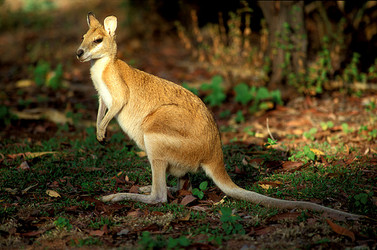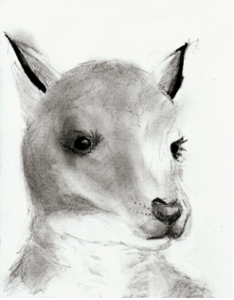General Description
The Agile Wallaby is closely related to kangaroos and wallaroos, who are also in the Marsupialia infraclass. Wallabies have long, flat feet and long tails - usually one third of their body height - which provide balance. No Macropodidae weigh over 25 kilograms. The Agile Wallaby has a brown back and tail which fades into a cream coloured chest and stomach. They are herbivores and usually eat grasses and leaves of shrubs, as well as occasionally feeding on the fruit on short bushes. As a result of their size, they are prone to being targeted by wild dogs that typically roam rural Australia.


Macropus agilis in Kakadu National Park, Northern Territory, Australia. © 2005 Wilf James.
Habitat
Wallabies are mainly found in Northern Australia and Papua New Guinea as well as in New Zealand. Unlike kangaroos, which enjoy living in wide open fields, wallabies prefer remote, heavily timbered regions and rugged areas. National Parks and nature reserves, especially on the off-shore islands of Western Australia as well as Wallaby Creek, on the north-eastern side of New South Wales, hold up to eleven species of wallabies.
Adaptations
Agile Wallabies have adapted to being in areas that are typically dry, often living in environments that require them to travel long distances. Wide feet and powerful hind legs are well suited to jumping, wallabies’ most efficient form of traveling. The wallaby is unusual in that its hind legs move in synchronization when jumping, yet also have the ability to kick independently when swimming. Rough skin on the surface of the feet enable the wallaby to grip hard-packed, dry earth, as well as rocky surfaces.
Wallaby feed on above-ground plants during the rainy season, but they have to resort to digging to unearth moisture-rich roots beneath the ground when food is scarce, in order to obtain sustainable levels of nutrition. Strong claws allow them to achieve this. Powerful molars are used to bite through thick stems and roots of low-lying shrubs and other plants.
The wallaby has darker fur on the back than on the stomach, helping it to camouflage itself among grasses and other plants, subsequently hiding from predators.
Reproductive Characteristics
Like all species from the Marsupialia infraclass, the Agile Wallaby is a marsupial. This means that, although mammals, they give birth to their offspring earlier than placental mammals. Wallabies raise their newborns, commonly known as joeys, in their pouches, at the base of the stomach. These pouches provide warmth and nourishment for the young. The newborns will spend about five months in the pouch before being considered adolescents. This form of birth and development reduces problems that come with longer pregnancies. There is also the benefit of not needing to internally carry a nutrient-demanding fetus during bad weather seasons in which the mother may be malnourished.


Macropus agilis mother with joey in pouch. © 2004 Wilf James
Classification
- Kingdom: Animalia
- Phylum: Chordata
- Class: Mammalia
- Infraclass: Marsupialia
- Order: Diprotodontia
- Family: Macropodidae
- Genus: Macropus
- Species: M. agilis
Risk of Endangerment
Although in some areas endangered due to hunting and loss of habitat, wallabies are often considered to be pests. This opinion is especially widely accepted in New Zealand, due to wallabies’ extensive consumption of cultivated crops. All Macropodidae except for species with the highest populations are protected from hunting in Australia by state and territory legislation. Commercial hunting of unprotected species is regulated under government-approved management programs. The wallabies’ greatest threat is loss of habitat due to urbanization, changing burning patterns, competition for territory and food with other species and wildfires.
Environmental Impact
The Agile Wallaby’s main impact on the environment is its contribution to soil erosion. During the wet season, when plants are available above ground, the wallaby feeds mostly on low-lying shrubs and grasses, whose roots help to hold the soil together. Wallabies pull out the roots of these plants, making the soil around them more susceptible to being blown and washed away.
Skippy the Wallaby
Skippy was a wallaby,
He had a lot of friends
He bounced around the outback,
And wore the latest trends.
One day the people came,
And took the land away
So Skippy and his family,
Had no place left to stay
They traveled to the desert,
Where the land was much too dry
Where the earth was red and sandy
And any plants that grew would die
Skippy couldn't take it,
He wanted to go back
So he woke up in the night,
And left without his pack
Skippy didn't have his things
And tried to go back home
But men caught him on the way,
And put him in a dome
Skippy was afraid
that the men had awful schemes
But once taken to reserves,
Skippy’s family was set free
Information on the Internet
- Macropus agilis Burian, J. 2002. Animal Diversity Web. Accessed 21 September 2008
- Kangaroo Biology Australian Government Department of the Environment, Water, Heritage and the Arts. 03 Sept. 07. Accessed 15 September 2008
- What is a Wallaby? Ellis-Christensen, Tricia. Wise Geek. Accessed 15 September 2008




 Go to quick links
Go to quick search
Go to navigation for this section of the ToL site
Go to detailed links for the ToL site
Go to quick links
Go to quick search
Go to navigation for this section of the ToL site
Go to detailed links for the ToL site